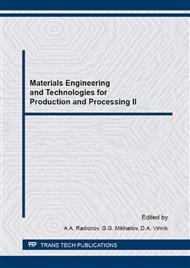[1]
A.N. Emelyushin, D.A. Mirzaev, N.M. Mirzaeva, E.V. Petrochenko, K. Yu. Okishev, O.S. Molochkova, Cast Tools of Chromium Cast Irons, Structure and Properties, MGTU Publ., Magnitogorsk, 2016. (in Russian).
Google Scholar
[2]
E.V. Rozhkova, O.M. Romanov, Optimizing the compositions of wear-resistant chromium cast irons, Metal Science and Heat Treatment. 26 (1984) 769-775. DOI: 10. 1007/BF00706516.
DOI: 10.1007/bf00706516
Google Scholar
[3]
D.A. Mirzaev, N.M. Mirzaeva, A.N. Emelyushin, Ledeburite alloys for tools for machining of graphite, Metal Science and Heat Treatment. 30 (1988) 519-523. DOI: 10. 1007/BF00777442.
DOI: 10.1007/bf00777442
Google Scholar
[4]
V.M. Kolokol'tsev, E.V. Petrochenko, P.A. Molochkov, Structure and wear resistance of chromium-vanadium cast irons, Izvestiya VUZ: Chernaya metallurgiya. 7 (2004) 25-28. (in Russian).
Google Scholar
[5]
F. Maratray, A. Poulalion, R. Fillit, H. Bruyas, The role of vanadium in high chromium white irons, Bulletin du cercle d'études des métaux. 15 (1983) 17-34.
Google Scholar
[6]
E.V. Petrochenko, T.S. Valishina, Effect of chemical composition, crystallization conditions and heat treatment on microstructure, mechanical and special properties of chromium-vanadium white cast irons, Izvestiya VUZ: Chernaya metallurgiya. 2 (2009).
Google Scholar
[7]
G.I. Sil'man, M.S. Frol'tsov, A.A. Zhukov, A.N. Prudnikov, Characteristics of the microstructure and distribution of elements in complex-alloy white cast irons, Metal Science and Heat Treatment. 23 (1981) 64-68. DOI: 10. 1007/BF00700309.
DOI: 10.1007/bf00700309
Google Scholar
[8]
A.A. Zhukov, G.I. Sil'man, M.S. Frol'tsov, Wear-Resistant Castings of Complex Alloy White Cast Irons, Mashinostroenie Publ., Moscow, 1984. (in Russian).
Google Scholar
[9]
L.M. Romanov, L. Ya. Kozlov, V.M. Bakamerov, Effect of V, Nb, Ta on crystallization and as-cast structure of chromium cast irons, Liteynoe proizvodstvo. 2 (1987) 8. (in Russian).
Google Scholar
[10]
I.I. Tsypin, White Wear-Resistant Cast Irons: Structure and Properties, Metallurgiya Publ., Moscow, 1983. (in Russian).
Google Scholar
[11]
M.M. Shteynberg, N.M. Mirzaeva, E.V. Kondratenko, Secondary quench hardening phenomenon in chromium cast iron, in: Issues of Steel Production and Treatment 188, Chelyabinsk Polytechnical Institute Publ., Chelyabinsk, 1975, pp.146-153.
Google Scholar
[12]
M.S. Potapova, I.G. Morozova, I. Ya. Sokol, Secondary hardness of alloy white irons, Metal Science and Heat Treatment. 27 (1985) 494-497. DOI: 10. 1007/BF00699576.
DOI: 10.1007/bf00699576
Google Scholar
[13]
Yu.D. Koryagin, Structural and phase transformations in secondary hardening heat treatment of high-carbon chromium-vanadium alloys, Bull. of the South Ural State Univ. Ser. Metallurgy. 14 (2014) 48-53. (in Russian).
Google Scholar
[14]
P. Dupin, J. Saverna, J. Schissler, Microstructure of white cast iron matrices with high chromium content, Bulletin du cercle d'études des métaux. 15 (1983) 35-47.
Google Scholar
[15]
M.V. Belous, V.T. Cherepin, M.A. Vasil'yev, Transformations in Steel Tempering, Metallurgiya Publ., Moscow, 1973. (in Russian).
Google Scholar
[16]
Yu.S. Dvoryadkin, Z.K. Kos'ko, Tempering of quench hardened high-chromium steel 3Kh13, in: Metallurgical and Mining Industry 8, Promin' Publ., Dnepropetrovsk, 1973, p.81–82. (in Russian).
Google Scholar
[17]
G. Miodrag, Martensite visokohromno Lieven grapes Vysoke tvrdotse resistance of abrazionohabaie, Tehnika (SFRJ). 39 (1984) 323–327.
Google Scholar
[18]
I.E. Polishchuk, Carbide formation in tempering of complex alloy steels as a function of chromium content, in: Alloying of steel and alloys, Kiev, 1975, p.40–44. (in Russ. ).
Google Scholar


